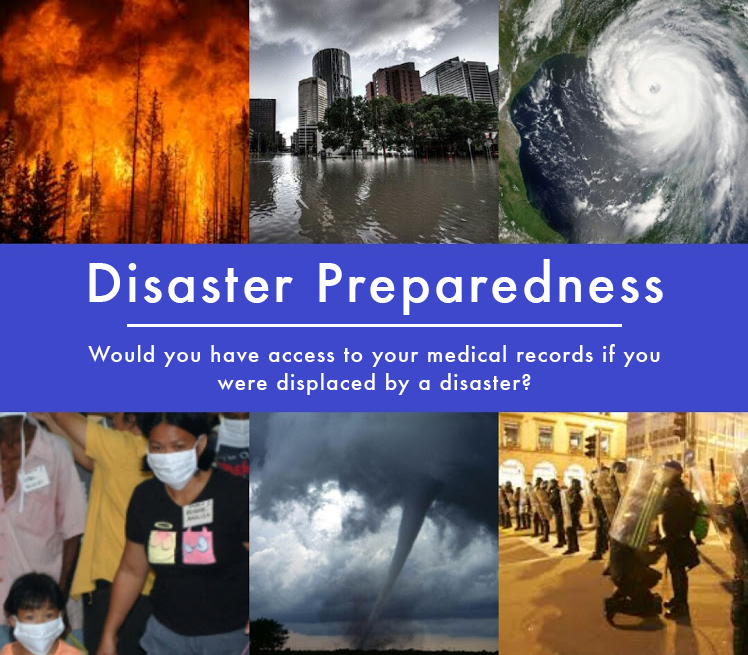Is a PHR Part of Your Disaster Preparedness Plan?
Regardless of the disaster type, most people evacuate a dangerous environment without any record of the medical treatments they have received, or any data regarding medications.

Have Personal Health Records Ready
During Hurricane Katrina more than one million paper-based medical records were destroyed. In the chaos of the California state wildfires of 2008 and the subsequent outbreak of the H1N1 virus, medical personnel had to rely on the memory of patients, family members, and friends to recall complex plans for medical care. “A lot of people walk in and say, ‘I take a little blue pill,’” without any idea what it was, said pediatrician Dr. Bethany Gardiner while treating evacuees in Baton Rouge, La in 2005.
Disasters arrive in various forms, often without warning. From hurricanes to wildfires, having a plan in place is critical.
One way is to adopt an electronic personal health record (PHR) to organize patient health history and document health conditions, medications, provider names and contact information, medical history and special needs.
The PHR is an electronic, lifelong resource of health information stored in a cloud. In times of disaster, health information is more likely to be recovered and retrieved through electronic means than if the information was stored on paper in a single location.
What should you have in your personal health records?
Allergies
A list of allergies to anything medical, such as antibiotics (eg. penicillin) and certain foods (eg. peanuts) or materials (eg. latex), can help emergency personnel determine cause and prevent symptoms that would muddle what is actually happening in the event of an emergency.
Medications
List any medications, including the dosage. Some medicines react badly together, so paramedics and doctors would need the information before giving additional medicine.
Pre-Existing Conditions
Conditions such as diabetes or asthma can have a huge effect on the treatments and tests available to emergency personnel in an emergency
Immunizations
If, for example, the doctor suspects an infection, keeping an up-to-date record of immunizations can help with a quick diagnosis.
Weight
A current weight is important to calculate dosages.
Family History
If a condition is common in the family, doctors can use that information to plan a diagnosis and treatment options.
Four Disaster Planning Questions
Can your family answer these questions?
1. Do you have a family emergency plan for bad weather, fire, and other emergencies?
Have you evaluated your family’s risk for certain disasters? Some families do not need to worry about hurricanes but must be prepared for tornadoes. Ready.gov has information on what do in the event of any disaster, whether natural or manmade, plus helpful risk assessments for your area.
2. Does your family have emergency supplies on hand?
A basic emergency supply kit could include:
- Water, one gallon of water per person per day for at least three days, for drinking and sanitation
- Food, at least a three-day supply of non-perishable food
- Battery-powered or hand crank radio and a NOAA Weather Radio with tone alert and extra batteries for both
- Flashlight and extra batteries
- First aid kit
- Toilet paper, moist towelettes, garbage bags and plastic ties for personal sanitation
- Wrench or pliers to turn off utilities
3. Do you have a designated safe area in your home or neighborhood?
Choose a safe area in the home and one someplace else in the neighborhood, depending on the emergency.
4. Do you all know what to do in case of an emergency?
Have a family meeting and plan where to go, what to do, and each family member’s responsibility during an emergency.
Title Image Credits (clockwise from top left): (1) Forest-fire, By Cameron Strandberg via Wikimedia Commons; (2) Looking downtown from Riverfront Ave Calgary Flood 2013, By Ryan L. C. Quanvia Wikimedia Commons; (3) Hurricane Katrina, By NASA via Wikimedia Commons; (4) Civil unrest in Lausanne, By Ramavia Wikimedia Commons (5) A tornado in central Oklahoma, By Daphne Zaras via Wikimedia Commons; (6) Patients don mask and began their walk up a ramp to medical treatment facilities the U.S. Military Sealift Command (MSC) Hospital Ship USNS Mercy (T-AH 19), By U.S. Navy photo [Public domain], via Wikimedia Commons.